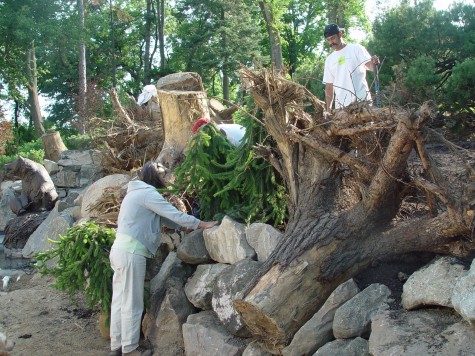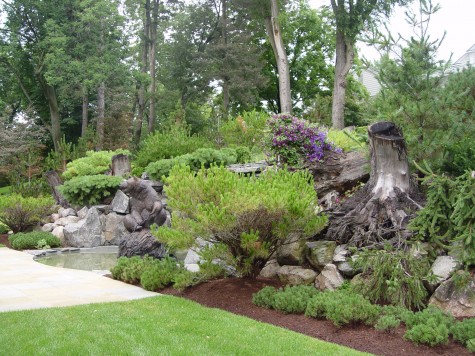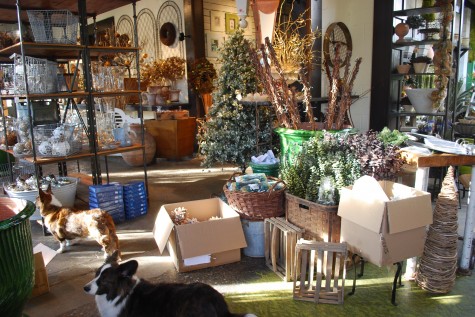 Though I shopped this past January for the holiday, and most everything was here this past August, I am never ready for what it really takes to change seasons. Have you ever? Even the corgis have that slightly appalled look on their faces. I am certain that the 10,000 square feet I have to deal with is secretly multiplying in the dead of night. It seems that everything needs to get moved-at least twice. Spaces have to be cleared-and of course cleaned-before they can be re-imagined. Sometimes it seems like my imagination will never ignite. When that everything involves stone, steel and lead, I have been known to daydream about being in the stamp-collecting business.
Though I shopped this past January for the holiday, and most everything was here this past August, I am never ready for what it really takes to change seasons. Have you ever? Even the corgis have that slightly appalled look on their faces. I am certain that the 10,000 square feet I have to deal with is secretly multiplying in the dead of night. It seems that everything needs to get moved-at least twice. Spaces have to be cleared-and of course cleaned-before they can be re-imagined. Sometimes it seems like my imagination will never ignite. When that everything involves stone, steel and lead, I have been known to daydream about being in the stamp-collecting business.
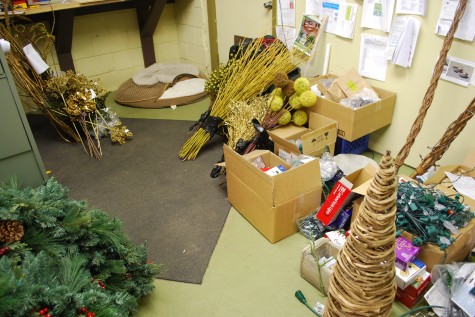 Rob likes everything imaginable in front of him all at once. The disaster that is his desk-loaded with messages, invoices, catalogues, notes, and all manner of other bits, spreads to the floorspace like a slime mold on steroids. This week he has been working away on the last of my leftover Halloween candy; the combination of his blood sugar level and his natural propensity to disorder defies description. Suffice it to say, I am living in a universe tending towards dissolution.
Rob likes everything imaginable in front of him all at once. The disaster that is his desk-loaded with messages, invoices, catalogues, notes, and all manner of other bits, spreads to the floorspace like a slime mold on steroids. This week he has been working away on the last of my leftover Halloween candy; the combination of his blood sugar level and his natural propensity to disorder defies description. Suffice it to say, I am living in a universe tending towards dissolution.
 The greenhouse fernery, so gorgeous a week ago, is now bulging with all those things that have lost their homes, and have no place to go. An impossibly delicate terra cotta pot with applied roses from Espace Buffon in Paris is one of a hundred fragile items crowding my office conference table. What floor space is still available makes walking through any room, objects in tow, nervewracking. Should anyone out there know of a small scale hovercraft rated for interior use, please let me know.
The greenhouse fernery, so gorgeous a week ago, is now bulging with all those things that have lost their homes, and have no place to go. An impossibly delicate terra cotta pot with applied roses from Espace Buffon in Paris is one of a hundred fragile items crowding my office conference table. What floor space is still available makes walking through any room, objects in tow, nervewracking. Should anyone out there know of a small scale hovercraft rated for interior use, please let me know.
 The rear portion of the shop is a cavernous garage-at least it seemed that way when I bought the building in 1995. Today every square foot has something going on, and not in any particular order. The arrangement of boxes so neatly shelved and stored has become completely unglued. The corgis treat this space like a formula one course, fraught with hairpin turns and unexpected obstructions. Great fun for them-not so much for me. This space needs to be shovelled out soon, such that we have room for the crew and materials necessary to construct of all our winter and holiday decor.
The rear portion of the shop is a cavernous garage-at least it seemed that way when I bought the building in 1995. Today every square foot has something going on, and not in any particular order. The arrangement of boxes so neatly shelved and stored has become completely unglued. The corgis treat this space like a formula one course, fraught with hairpin turns and unexpected obstructions. Great fun for them-not so much for me. This space needs to be shovelled out soon, such that we have room for the crew and materials necessary to construct of all our winter and holiday decor.
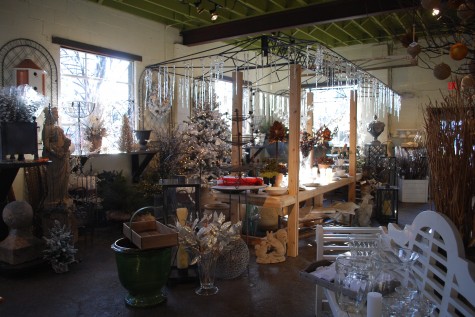 Progress has been made; certain big gestures are in place. Every box I unpack, I hope I remember what I was thinking when I bought ,works out. My idea of holiday has everything to do with materials and references to the garden. This part is simple. It takes a great deal of concentration to shop materials from 30 or better vendors such that you end up with a cohesive collection; this is only the beginning. Remembering what I had in mind over 10 months ago-even my notes don’t ring any bells. The materials pile up faster than I can do display; just this morning a semi truckload of twigs arrived. At this moment, the driveway is impassable.
Progress has been made; certain big gestures are in place. Every box I unpack, I hope I remember what I was thinking when I bought ,works out. My idea of holiday has everything to do with materials and references to the garden. This part is simple. It takes a great deal of concentration to shop materials from 30 or better vendors such that you end up with a cohesive collection; this is only the beginning. Remembering what I had in mind over 10 months ago-even my notes don’t ring any bells. The materials pile up faster than I can do display; just this morning a semi truckload of twigs arrived. At this moment, the driveway is impassable.
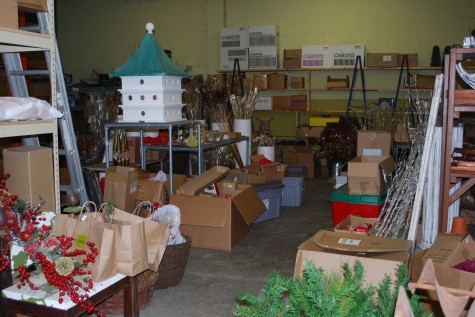
Though this scene smacks of a storage facility whose loading in has never been accompanied by any loading out, my clients seem to like this phase. They amiably poke through everything, and have no problem asking to have a promising box opened for them-thank heavens. They even go so far as to say how beautiful everything looks-I think they feel sorry for me. This process takes a month anyway, start to finish. I learned a long time ago, if you do not set a deadline, you will never be done.
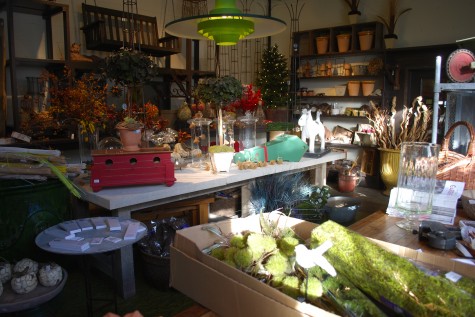 Next week Thursday November 12th is our deadline. We host an evening holiday preview and shopping soiree for our clients. Our 4pm to 9pm event ran until 11:30 last year. We serve a little something to eat and drink; lots of people come, and we have a great time. We aim for picture perfect, we are 6 days out and counting. I don’t see how we will be ready this minute, but somehow we will get there. Stop in, should you have a chance.
Next week Thursday November 12th is our deadline. We host an evening holiday preview and shopping soiree for our clients. Our 4pm to 9pm event ran until 11:30 last year. We serve a little something to eat and drink; lots of people come, and we have a great time. We aim for picture perfect, we are 6 days out and counting. I don’t see how we will be ready this minute, but somehow we will get there. Stop in, should you have a chance.
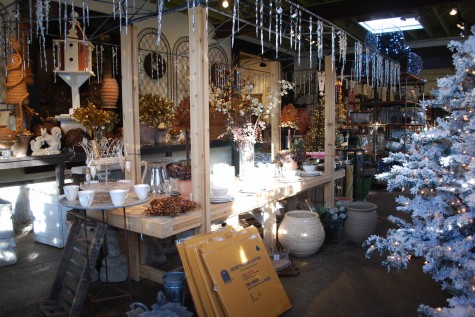
Now, where was I?
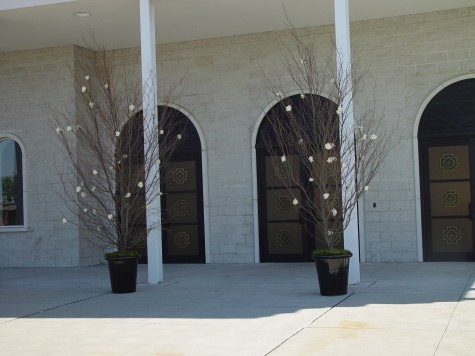
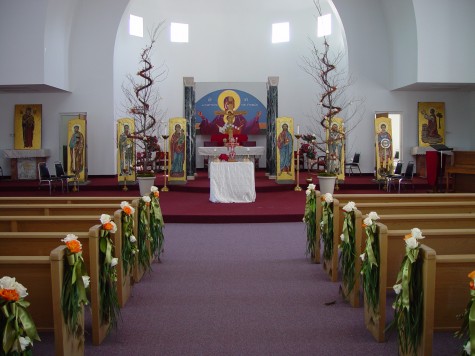 This gorgeous Melkite Catholic church needed little in the way of decoration; the beautifully vaulted white-walled interior was formally appointed with iconographic paintings of figures central to their faith. I found four 3″ beech that had not survived the season in my landscape supplier’s bone yard; they would be destined for another kind of life. Bare grapevine garland would be dressed up with bitterweet vine and the rose “Hollywood”. No other white rose opens so beautifully, and stays fresh longer, out of water. The pews we marked simply with sprays of grasses with seed heads intact, to which we added orange and white roses. The dressy olive green double faced satin formally acknowledged the space, and the occasion.
This gorgeous Melkite Catholic church needed little in the way of decoration; the beautifully vaulted white-walled interior was formally appointed with iconographic paintings of figures central to their faith. I found four 3″ beech that had not survived the season in my landscape supplier’s bone yard; they would be destined for another kind of life. Bare grapevine garland would be dressed up with bitterweet vine and the rose “Hollywood”. No other white rose opens so beautifully, and stays fresh longer, out of water. The pews we marked simply with sprays of grasses with seed heads intact, to which we added orange and white roses. The dressy olive green double faced satin formally acknowledged the space, and the occasion. 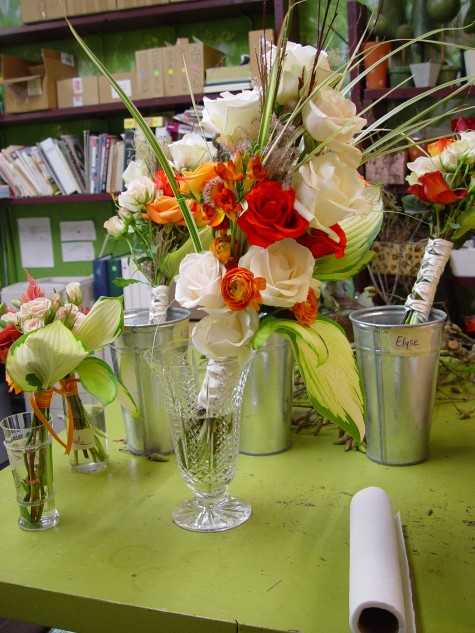 Even the bride’s bouquet included delicate birch branches. Variegated miscanthus grass and hosta complimented the orange freesia, ranunculus and roses. The bare stems were dressed in braided satin ribbon; the contrast in materials is particularly lovely.
Even the bride’s bouquet included delicate birch branches. Variegated miscanthus grass and hosta complimented the orange freesia, ranunculus and roses. The bare stems were dressed in braided satin ribbon; the contrast in materials is particularly lovely. 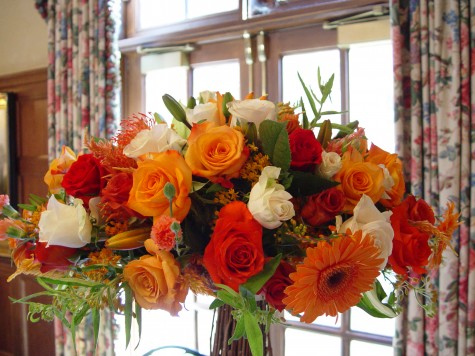
 Stout bundles of willow sticks get my flowers in the air. The rustic fiber pots filled with hemp fiber make an unmistakable reference to the garden. The metal pole set in concrete not seen here is an apparatus which keeps the flowers aloft securely.
Stout bundles of willow sticks get my flowers in the air. The rustic fiber pots filled with hemp fiber make an unmistakable reference to the garden. The metal pole set in concrete not seen here is an apparatus which keeps the flowers aloft securely.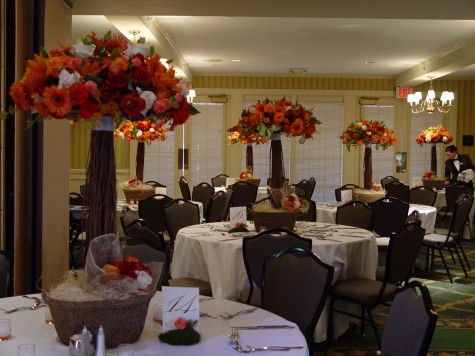 The generic quality of the room fades away; what is left is a celebration of saturated fall color, and a very important event involving family and friends. The tabletop level decor has interest and presence which will please the eye, but not obstruct anyone’s view.
The generic quality of the room fades away; what is left is a celebration of saturated fall color, and a very important event involving family and friends. The tabletop level decor has interest and presence which will please the eye, but not obstruct anyone’s view.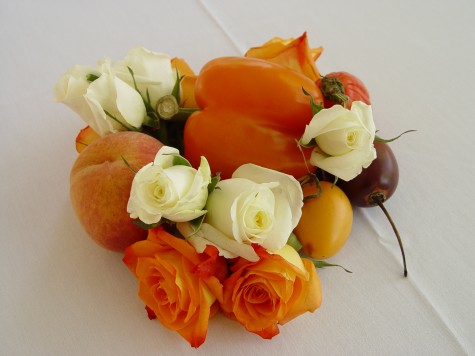
 Celeste provided the table numbers, the calligraphy of her own hand. Large pieces of mood moss, when grooved, made naturally beautiful stands. The fresh green acorns-another nod to the season.
Celeste provided the table numbers, the calligraphy of her own hand. Large pieces of mood moss, when grooved, made naturally beautiful stands. The fresh green acorns-another nod to the season. 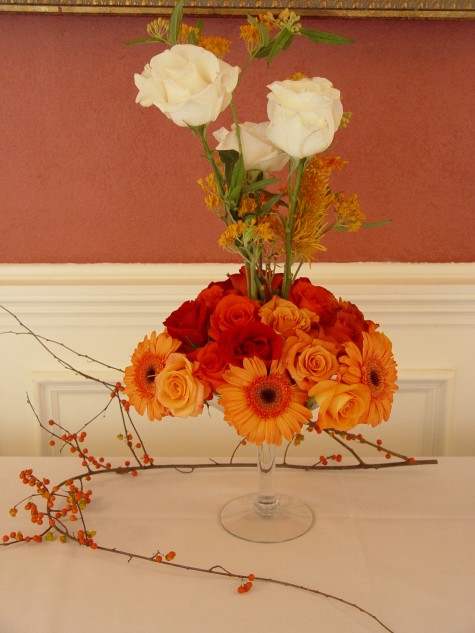 The effect of these flowers is so enhanced by the company of a length of bittersweet vine. The vine creates a visual context for the flowers. The creation of a visual world complete and believable is a daily challenge in the store; important events demand this too.
The effect of these flowers is so enhanced by the company of a length of bittersweet vine. The vine creates a visual context for the flowers. The creation of a visual world complete and believable is a daily challenge in the store; important events demand this too.
 My November garden is radically different and edited in character from what I see in the summer-but characters there are. The willows are coming into their own. I wouldn’t give a nickel for a willow in the summer-save the dwarf blue artic willow. Its graceful branches almost always in motion can recreate the feeling of a meadow in a small space. Other willows are coarse in leaf and ungainly in habit-in a word, park-grade. Should you have acres such that the willows can be planted comfortably far away in your park, fine. There are too many other more civilized choices for my small garden to give over space to this group. In November, I rue my rule. The cut branches of salix sachaliensis “sekka” pictured above would not make you rush to your local nursery to buy one, but as with most willows, their bold branches shine now. When the willow leaves finally drop, I kick myself for not having an entire hedge of it in the ground.
My November garden is radically different and edited in character from what I see in the summer-but characters there are. The willows are coming into their own. I wouldn’t give a nickel for a willow in the summer-save the dwarf blue artic willow. Its graceful branches almost always in motion can recreate the feeling of a meadow in a small space. Other willows are coarse in leaf and ungainly in habit-in a word, park-grade. Should you have acres such that the willows can be planted comfortably far away in your park, fine. There are too many other more civilized choices for my small garden to give over space to this group. In November, I rue my rule. The cut branches of salix sachaliensis “sekka” pictured above would not make you rush to your local nursery to buy one, but as with most willows, their bold branches shine now. When the willow leaves finally drop, I kick myself for not having an entire hedge of it in the ground. 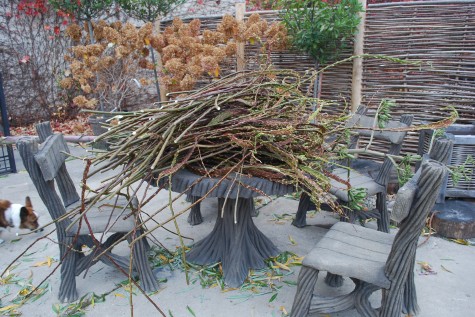 Commonly known as fantail willow, this shrubby plant is known for its fasciated stems. OK-I will cover the science as fast as I can. Meristem cells, from whence all parts of the plant grow, are dome shaped; they produce the cylindrical shapes we know as branches. Either from mutation, or some other force not clearly understood, some meristem cells flatten out, and elongate, producing wide flat stems that may curl in a most unusual way. These bold branches are gorgeous in the garden, and in fall and winter arrangements.
Commonly known as fantail willow, this shrubby plant is known for its fasciated stems. OK-I will cover the science as fast as I can. Meristem cells, from whence all parts of the plant grow, are dome shaped; they produce the cylindrical shapes we know as branches. Either from mutation, or some other force not clearly understood, some meristem cells flatten out, and elongate, producing wide flat stems that may curl in a most unusual way. These bold branches are gorgeous in the garden, and in fall and winter arrangements.  Some floral supply places carry dried fantail willow, but I prize the the fresh cut stems. Each branch colors up individually in the fall in shades of red, green and brown. The cut branches retain their color outdoors in cold weather a very long time; they make a striking centerpiece in holiday and winter pots, in wreaths and door swags.
Some floral supply places carry dried fantail willow, but I prize the the fresh cut stems. Each branch colors up individually in the fall in shades of red, green and brown. The cut branches retain their color outdoors in cold weather a very long time; they make a striking centerpiece in holiday and winter pots, in wreaths and door swags. 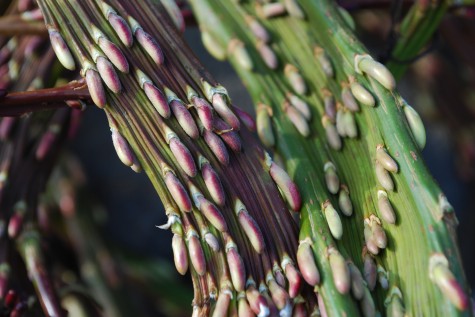 The grooves and furrows, a direct result of the process of fasciation, make for a very bold texture. Note the elongated the leaf buds set for spring. Fasciation can occur in many plants-I have seen two-headed dandelions, and thick flat stems of bulb lilies with their bouffant hairdo of flowers clustered at the top. Some plants may produce stems like this intermittently-these are called witches brooms, after the look of that proliferation of branches. Some witches brooms are cut, and propagated from cuttings. Certain dwarf conifers with very congested and odd branching patterns of questionable appeal come to market via a chance fasciation.
The grooves and furrows, a direct result of the process of fasciation, make for a very bold texture. Note the elongated the leaf buds set for spring. Fasciation can occur in many plants-I have seen two-headed dandelions, and thick flat stems of bulb lilies with their bouffant hairdo of flowers clustered at the top. Some plants may produce stems like this intermittently-these are called witches brooms, after the look of that proliferation of branches. Some witches brooms are cut, and propagated from cuttings. Certain dwarf conifers with very congested and odd branching patterns of questionable appeal come to market via a chance fasciation. 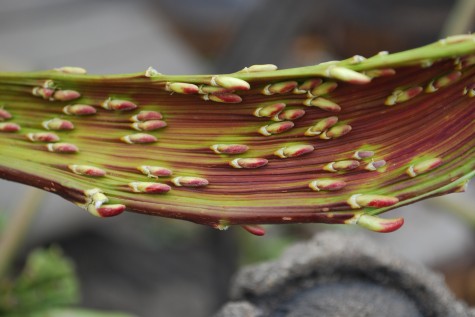 Color can be tough to come by this time of year where I live. I love the natural greys, browns and blacks common to the season, but I so appreciate robust color in a landscape that has by and large gone dormant.
Color can be tough to come by this time of year where I live. I love the natural greys, browns and blacks common to the season, but I so appreciate robust color in a landscape that has by and large gone dormant.
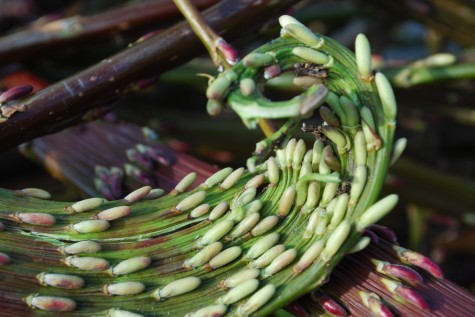
 Some months ago I wrote an essay about designing a landscape for a sculpture, but perhaps equally as sculptural were the tree trunks that played such a critical role in the realization of that design. I do not think I ever physically understood what a tree was all about until I was face to face with these stumps. Farmers need to clear land to plant their crops; this means digging out the stumps. The microorganisms that decompose wood work at a snail’s pace. In farm areas in Michigan it is common to see fences made from these stumps. For this project, I persuaded a farmer to part with 150 feet of his fence. The experience would provide me with a graphic understanding of what goes on inside the bark of a tree.
Some months ago I wrote an essay about designing a landscape for a sculpture, but perhaps equally as sculptural were the tree trunks that played such a critical role in the realization of that design. I do not think I ever physically understood what a tree was all about until I was face to face with these stumps. Farmers need to clear land to plant their crops; this means digging out the stumps. The microorganisms that decompose wood work at a snail’s pace. In farm areas in Michigan it is common to see fences made from these stumps. For this project, I persuaded a farmer to part with 150 feet of his fence. The experience would provide me with a graphic understanding of what goes on inside the bark of a tree. 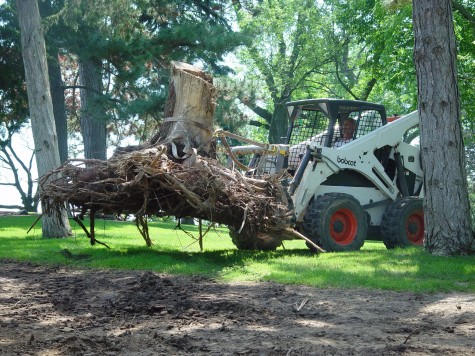 What arrived by flatbed was vastly more than I had bargained for. They stood eight feet tall and were much better than that in width. Though the fence had been in place for 10 years, handling the size and weight of them was a strain both for my crew, and my bobcat skid steer. The thick wiry roots were as unyielding as steel. It is so easy to stop truly seeing those things one sees every day. A lifetime of seeing these giant living things rising out of the ground to incredible heights had apparently dulled my sense of them.
What arrived by flatbed was vastly more than I had bargained for. They stood eight feet tall and were much better than that in width. Though the fence had been in place for 10 years, handling the size and weight of them was a strain both for my crew, and my bobcat skid steer. The thick wiry roots were as unyielding as steel. It is so easy to stop truly seeing those things one sees every day. A lifetime of seeing these giant living things rising out of the ground to incredible heights had apparently dulled my sense of them. 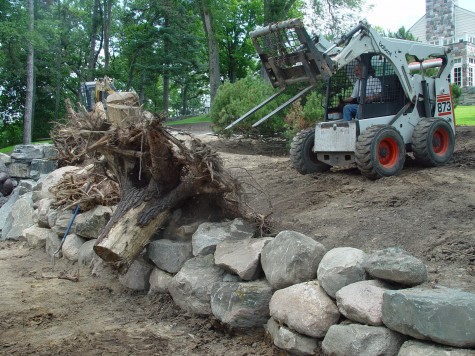 I was so struck by how the heart of a tree lives on long after its green life has gone down. The heartwood is transformed by an internal chemical process into a material of great strength. The wood of a tree enables nutrients to travel from the roots to the leaves, its core function is to keep the plant upright. This exposure to wood is much different than looking at planks, or plywood, porch furniture, or fuel for my fireplace. Processed wood is obviously a material that few could do without, but these raw forms are incredibly beautiful.
I was so struck by how the heart of a tree lives on long after its green life has gone down. The heartwood is transformed by an internal chemical process into a material of great strength. The wood of a tree enables nutrients to travel from the roots to the leaves, its core function is to keep the plant upright. This exposure to wood is much different than looking at planks, or plywood, porch furniture, or fuel for my fireplace. Processed wood is obviously a material that few could do without, but these raw forms are incredibly beautiful.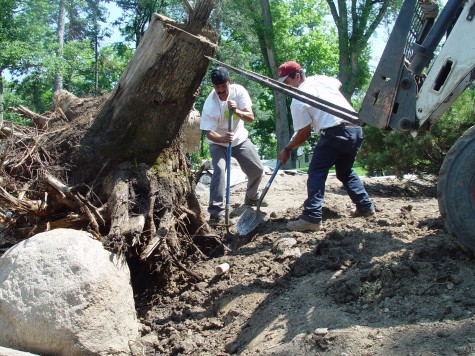 Setting them in place took days. Placing them close to the final location was done by machine. This was just the beginning; as I wanted them to look as though they might had always been there, we dug them in. The forks on the skid steer held the stumps in place, as it would have taken an army to do that by hand. Though this group of trees was no longer living, the story of how the network of feeder and support roots broadly rise out of the ground and grow to support these very large plants is there to read.
Setting them in place took days. Placing them close to the final location was done by machine. This was just the beginning; as I wanted them to look as though they might had always been there, we dug them in. The forks on the skid steer held the stumps in place, as it would have taken an army to do that by hand. Though this group of trees was no longer living, the story of how the network of feeder and support roots broadly rise out of the ground and grow to support these very large plants is there to read. 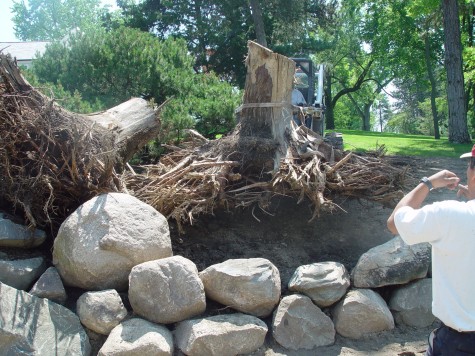
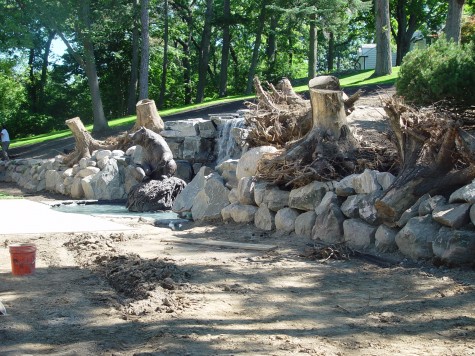 It is a very good idea to consider what will need to go on below ground, and what will eventually be-before planting a large growing tree. I have had occasion to tell clients that their silver maples were an excellent example of God’s biggest weeds. Urban lots and tree lawns are poor locations for giant trees. They suffer from restricted space and rootzones. Given that it takes a long time to grow a tree, imagining the eventual size at the beginning only makes good sense.
It is a very good idea to consider what will need to go on below ground, and what will eventually be-before planting a large growing tree. I have had occasion to tell clients that their silver maples were an excellent example of God’s biggest weeds. Urban lots and tree lawns are poor locations for giant trees. They suffer from restricted space and rootzones. Given that it takes a long time to grow a tree, imagining the eventual size at the beginning only makes good sense. This nine foot tall bronze bear seated on his beaver’s nest is getting some company of a similar scale. The rain to come will wash the stumps. The digging in will deposit soil in pockets, enabling plants to grow. A collection of dwarf conifers would cover the ground.
This nine foot tall bronze bear seated on his beaver’s nest is getting some company of a similar scale. The rain to come will wash the stumps. The digging in will deposit soil in pockets, enabling plants to grow. A collection of dwarf conifers would cover the ground.